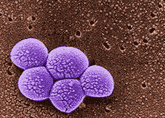New research led by IBM Research-Almaden and the Institute of Bioengineering and Nanotechnology has developed a new treatment for drug-resistant superbugs such as Staphylococcus aureus (MRSA). The new MRSA treatment uses tiny nanotechnology structures to attack the cell membrane of MRSA bacteria.
This scientific breakthrough in a nanotechnology treatment might solve the massive of problem of drug resistant bacteria. Antibiotics have long been an essential player in the fight against bacteria and infections. However, their prolific use has created a significant hazard. Since antibiotics attack bacteria from within by passing through the cell membrane and disrupting the bacteria's DNA, the microbes can easily develop a resistance to these antibiotics.
IBM's new nanotech treatment hopes to bypass this problem by using tiny nano-structures to attack and destroy bacteria's cell membrane. This technique would prevent bacteria from becoming resistant to treatment and would significantly help the fight against MRSA by killing the drug-resistant bacteria even after antibiotic treatments have failed.

(Image of MRSA bacteria courtesy of Centers for Disease Control and Prevention)
Additionally, the nanotech treatment is less harmful to the treated patients. While MRSA antibiotics attack both healthy and infected cells indescriminantly, the nanostructures can discriminate between healthy red blood cells and infected cells by detecting the electric charges each produces. During tests of the nanostrucutures there was no rupturing of healthy red blood cells even at doses 10 times higher than normal.
The new treatment would employ biodegradable nanostructures made of polycarbonate polymer. The structures are only 200 nanometers across and would reassemble themselves into a shape designed to disintegrate bacteria cell membranes when they came into contact with water on the skin or in the body.
After the structures had successfully destroyed the bacterial infection they could be easily biodegraded by enzymes in the body and flushed out of the patient's system.
Although IBM's new nanotechnology treatment is far from complete it has enormous implications for the fight against MRSA. During the last yearly study by the U.S. Centers for Disease Control 19,000 Americans were killed by the MRSA infection. This new nanotechnology treatment has the potential to help or even cure thousands of patients suffering from MRSA and other drug-resistant superbugs.
This article is brought to you by Biotechnology Calendar, Inc. If you are interested in meeting and networking with University researchers who are pursuing nanotechnology research projects throughout the country, plan on attending one our BioResearch Product Faires™ at a leading U.S. research University, to register to exhibit at our upcoming show at UCSF.
 What new areas of research could this technology be applied to? Please comment below.
What new areas of research could this technology be applied to? Please comment below.

